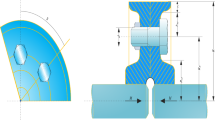Abstract
Due to the continuous refinements in engineering operations, process parameters need to be optimised in order to improve the production quality. In this study we present a novel method based on the hybridisation of an ant colony system search mechanism with a steepest ascent method to achieve such a parameter optimisation. The proposed algorithm has been implemented and run on two real time industrial applications. Experimental results showed that the optimised parameters for a stealth laser dicing process provided by the new method were able to increase the production quality by improving production precision, which is measured in terms of average deviation from the expected result and relative variance. The novel method we propose was able to identify improved settings for a stealth laser dicing process with five parameters, resulting in a greatly reduced rate of product failures. Additionally six parameters were optimised for another industrial application, namely a grease filling system with twin towers, using only 23 experiments, leading to an increase in the tool life (objective of the optimisation) from the previous average of 9236 U produced to 13,883 U. The new method performed better than conventional response surface methods, showing therefore to be promising for other similar industrial applications.














Similar content being viewed by others
References
Baskar, N., Asokan, P., & Prabhaharan, G. (2005). Optimisation of machining parameters for milling operations using non-conventional methods. The International Journal of Advanced Manufacturing Technology, 25(11), 1078–1088.
Chen, H., Zhang, J., Dang, Y., & Shu, G. (2014). Optimisation for immobilisation of \(\beta \)-galactosidase using plackettburman design and steepest ascent method. Journal of Chemical and Pharmaceutical Research, 6(4), 612–616.
Çiçek, A., Kıvak, T., & Ekici, E. (2015). Optimisation of drilling parameters using Taguchi technique and response surface methodology (RSM) in drilling of AISI 304 steel with cryogenically treated HSS drills. Journal of Intelligent Manufacturing, 26(2), 295–305.
Dorigo, M., & Stutzle, T. (2004). Ant colony optimisation. Massachusetts: The MIT Press Cambridge.
Edwards, D. J., & Fuerte, J. N. (2011). Compromise ascent directions for multiple-response applications. Quality and Reliability Engineering International, 27(8), 1107–1118.
Harrington, E, Jr. (1965). The desirability function. Industrial Quality Control, 21, 494–498.
Hron, J., & Macak, T. (2013). Optimisation of food packaging to improve food safety. Journal of Food, Agriculture and Environment, 11(3–4), 423–428.
Joyce, A. P., & Leung, S. S. (2013). Use of response surface methods and path of steepest ascent to optimise ligand-binding assay sensitivity. Journal of Immunological Methods, 392, 12–23.
Kuo, C. F. J., Lan, W. L., Chang, Y. C., & Lin, K. W. (2016). The preparation of organic light-emitting diode encapsulation barrier layer by low-temperature plasma-enhanced chemical vapor deposition: a study on the SiO x N y film parameter optimisation. Journal of Intelligent Manufacturing, 27(3), 581–593.
Kumagai, M., Uchiyama, N., Ohmura, E., Sugiura, R., Atsumi, K., & Fukumitsu, K. (2007). Advanced dicing technology for semiconductor wafer-stealth dicing. IEEE Transactions on Semiconductor Manufacturing, 20(3), 259–265.
Lee, K. S., & Geem, Z. W. (2005). A new meta-heuristic algorithm for continuous engineering optimisation: harmony search theory and practice. Computer Methods in Applied Mechanics and Engineering, 194, 3902–3933.
Lin, W. T., Tsao, L. C., Shie, A. J., Chang, S. T., & Yang, T. C. (2016). The application of Taguchi methods to parameters optimisation for preventing coagulation in artificial kidneys. Journal of Industrial and Production Engineering, 33(4), 247–252.
Montgomery, D. C. (2012). Design and analysis of experiments. New York: Wiley.
Mukherjee, R., Chakraborty, S., & Samanta, S. (2012). Selection of wire electrical discharge machining process parameters using non-traditional optimisation algorithms. Applied Soft Computing, 12, 2506–2516.
Myers, R. H., Montgomery, D. C., & Anderson-Cook, C. M. (2016). Response surface methodology: process and product optimisation using designed experiments. New York: Wiley.
Saravanan, R., Sankar, R. S., Asokan, P., Vijayakumar, K., & Prabhaharan, G. (2005). Optimisation of cutting conditions during continuous finished profile machining using non-traditional techniques. The International Journal of Advanced Manufacturing Technology, 26(1), 30–40.
Sibalija, T. V., & Majstorovic, V. D. (2012). An integrated approach to optimise parameter design of multi-response processes based on Taguchi method and artificial intelligence. Journal of Intelligent Manufacturing, 23(5), 1511–1528.
Taguchi, G., Yokoyama, Y., & WU, Y. (1993). Taguchi methods—Design of experiments. Dearborn, Michigan: ASI Press.
Zhang, B., Chen, D., & Zhao, W. (2005). Iterative ant-colony algorithm and its application to dynamic optimisation of chemical process. Computers & Chemical Engineering, 29(10), 2078–2086.
Zhang, J., Sun, H., Pan, C., Fan, Y., & Hou, H. (2016). Optimisation of process parameters for directly converting raw corn stalk to biohydrogen by clostridium sp. FZ11 without substrate pretreatment. Energy and Fuels, 30(1), 311–317.
Zirehpour, A., Rahimpour, A., Jahanshahi, M., & Peyravi, M. (2014). Mixed matrix membrane application for olive oil wastewater treatment: Process optimisation based on Taguchi design method. Journal of Environmental Management, 132, 113–120.
Acknowledgments
This work was supported by the National Research University Project of Thailand Office of Higher Education Commission. The first author wishes to thank the Faculty of Engineering, Thammasat University, THAILAND.
Author information
Authors and Affiliations
Corresponding author
Rights and permissions
About this article
Cite this article
Luangpaiboon, P., Boonhao, S. & Montemanni, R. Steepest ant sense algorithm for parameter optimisation of multi-response processes based on taguchi design. J Intell Manuf 30, 441–457 (2019). https://doi.org/10.1007/s10845-016-1257-3
Received:
Accepted:
Published:
Issue Date:
DOI: https://doi.org/10.1007/s10845-016-1257-3




